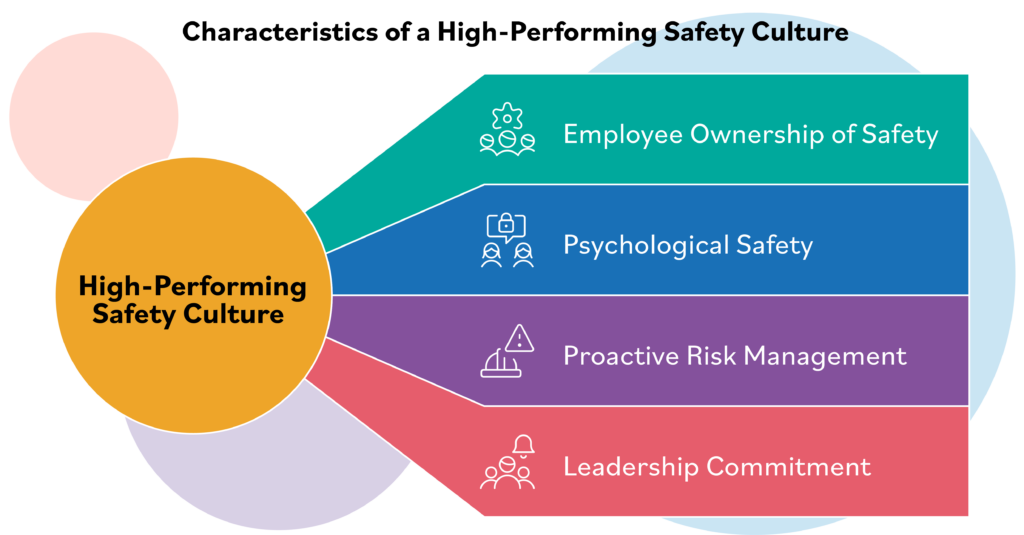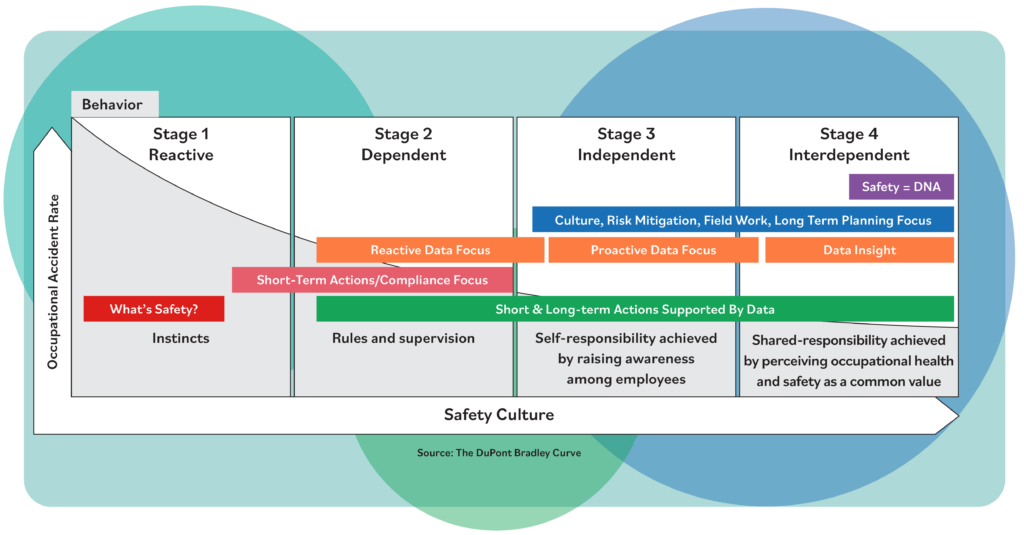Culture vs. Compliance: Building a Sustainable and Balanced Safety Mindset
May 1, 2025
8 minute read

As we explore deeper into our Balanced Safety focus series, we see many organizations struggling to move beyond the idea of compliance-driven safety programs. One primary directive is to ensure the company is compliant with regulations, and though compliance is often the starting point, it alone doesn’t always deliver the desired level of success.
The best answer to addressing this gap is to explore strategies to create a safety mindset that fosters better compliance through engagement, accountability, and continuous improvement.
To achieve this balance, where different stakeholders with different responsibilities must be engaged and encouraged using different means, we’ll consider ways EHS practitioners can drive compliance as part of an overall safety balance while nurturing an innovative culture that’s sustainable, efficient, and effective.
Scott Gaddis presented a webinar and wrote a guide on the topic.

Management system integration
A balanced safety approach creates a solid foundation for progress by integrating multiple dimensions of workplace safety, connecting key parts of the business management system.
For example, it’s not uncommon for quality issues to affect safety performance in the facility, or for operations’ demands for higher production output to result in safety concerns or issues. Nearly everything within the business has the potential to influence safety performance in some way, whether positively or negatively.
Enterprises can reduce unwanted impacts driven by other areas of the business by balancing the safety process. This ensures that no single aspect of safety dominates at the expense of others.

A balanced approach also fosters an environment where multiple factors are considered and addressed, including:
- Physical factors
- Psychological factors
- Organizational factors
- Technological factors
By integrating these dimensions of workplace safety and connecting them to parts of the business management system, organizations can create a comprehensive and effective safety management system.
This alignment ultimately reduces inefficiencies and empowers the business to leverage more opportunities for safety improvements.

Safety process drivers and challenges
When considering the links between compliance and culture within EHS, several key drivers should be in place to promote a better safety process.
- Consistent leadership mindset and corporate commitment: EHS often flourishes when business leaders value and support safety practitioners’ improvement goals. Senior-level sponsors should be committed to, and rigorously follow, the organization’s safety process.
- A life-cycle approach to health and safety: Periodic investments will be needed in infrastructure and management systems to support and encourage long-term improvement. This also means securing funding and other resources necessary to mitigate identified threats to the safety process.
- Compliance and regulatory framework adherence: Safety practitioners need a clear understanding of the regulatory frameworks relevant to their workplaces. This involves knowing the regulations that affect the various aspects of the business, whether at a corporate level or an individual site level. Regulatory frameworks, in addition to being standalone safety drivers, also act as catalysts to the process of EHS implementation. Stakeholders must first comply with the existing rules and regulations before additional progress can be made.
- Dedication to awareness, education, and training: Pivoting short-term focus areas (responding to discrete safety events, etc.) toward addressing long-term detrimental effects on the workplace environment enables companies to mitigate these unwanted effects more effectively. Consistent communication of occupational hazards helps build the work population’s awareness of safety needs and practices, and training, like our new partnership with MARCOM, must be offered to empower employees to act on identified hazards and build muscle memory around good EHS practices.
- A deliberate and thoughtful safety culture: Regulatory elements and compliance objectives set a necessary baseline. The culture is the innovative piece that drives EHS programs forward, beyond minimum requirements and toward a more proactive approach to risk management. Read our mini-guide on creating and sustaining a safety culture to learn more.

Enterprises must also be aware of common challenges that complicate and threaten the safety process.
- Competing priorities that stem from balancing compliance with operational efficiency. Production quotas increase, cost pressures continue, and these—along with other factors—can be a threat to advancing the efforts of health and safety.
- Managing a complex and ever-changing regulatory landscape is an ongoing concern, particularly for enterprises with multiple locations that may fall under the purview of different regulatory agencies. Enforcement levels may vary depending on the region, and the interpretation of a requirement could be different from one inspector to another.
- Employee engagement and cultural shifts within the organization can seriously disrupt or even undo your safety process if perceptions, actions, or support trend in a negative way. These shifts can happen quickly and with very little warning.
- Risk assessment and mitigation efforts conducted while supporting operational objectives are constantly evolving because safety lives in a quantified system. It’s easy to fall into a reactive way of working if EHS priorities don’t maintain alignment with the legitimate areas of risk in the work environment.
Understanding opportunities, core drivers, and barriers to success will help you shape a more balanced safety process.
Getting to the right compliance-culture balance
Compliance sets the foundation for safety, but most regulations are set as minimum standards. They’re the baseline for what is accepted and what will ensure that legal standards are met. However, rarely are people pleased with achieving minimal results, and safety programs are nearly universal in setting goals that extend beyond that.
On the other side of the scale is culture. Corporate safety culture alone is not enough to guarantee regulatory compliance or to turn a hazardous work environment into a safe one. But culture is a primary driver of behavior, engagement, and our perception of our workplace.
When considering the balance between culture and compliance, EHS practitioners can begin by:
- Ensuring robust baselines of regulatory compliance through clear policies, training, audits, and related motions.
- Efforts to engage employees at all levels will help create the right culture for safety.
- Stakeholders at every level of the business should understand safety as a shared value.
- The EHS team can then use the common visions of success in compliance and success in culture to encourage the proactive behaviors necessary for safety process improvements.
How to get started finding this balance:
Look at where the safety team spends its time today and consider if the split between culture and compliance is ideal.
If the balance isn’t what you want it to be, you may choose to integrate compliance with culture more closely by demonstrating how following compliance objectives aligns with the organization’s core values and enhances overall well-being.
Another strategy is to elevate the organization’s commitment to a robust baseline of regulatory compliance that exceeds the minimum standards. This can be accomplished through clear policies, training, and audits.
You can also build more value around culture by embedding “why” discussions into compliance, such as exploring the underlying value of a regulation or rule and how it protects people. This gradually shifts mindsets toward a more balanced center without compromising compliance or sacrificing culture.
It can also be useful to utilize the process developed by DuPont to assess where the business is today and identify steps to improve the culture-compliance balance.

Evaluate where your company falls on the four stages of Reactive, Dependent, Independent, Interdependent.
With a candid assessment of your current position, you can more effectively identify potential barriers to safety growth and emphasize an optimal blend of foundational compliance actions and cultural evolution to achieve sustained safety performance.
How technology can improve safety’s compliance-culture balance
Technology is an important lever that can help EHS practitioners overcome barriers to a more balanced safety process.
Traditionally, digital tools have focused on compliance, offering features such as:
- Regulatory compliance management
- Real-time audits and inspections
- Comprehensive reporting to streamline regulatory efforts
But, today’s modern solutions also drive culture forward by enabling:
- Stronger, real-time communication
- Greater accessibility for all roles—frontline to executive
- Insights and recommendations through powerful analytics
At the individual level, mobile tools bring safety to the worker:
- Easy-to-use apps make safety accessible and interactive.
- Employees can report observations, complete JSAs, and access checklists directly from their smartphones.
- Gamification features—like leaderboards, rewards, and real-time feedback—motivate proactive safety behavior.
- Bi-directional channels encourage employees to speak up and stay engaged.
By putting the safety system directly into employees’ hands, technology becomes a cultural driver—enhancing participation, visibility, and ownership across the organization.
At the organizational level, a comprehensive safety platform should:
- Simplify complex processes
- Adapt to different operational needs
- Scale with business growth
It should also support leadership engagement by:
- Providing real-time dashboards for safety performance tracking
- Enabling data-driven decision-making
- Delivering executive reports that highlight trends, compliance status, and workforce engagement
- Sending role-specific alerts to keep leaders aligned and responsive
Finally, advanced technologies push safety into a proactive future. Innovative platforms now include:
- Prescriptive analytics and AI for deep insight
- Culture-Based Safety (CBS) tracking to measure engagement effectiveness
- Continuous improvement tools to identify and prevent repeat incidents
Creating your own balanced safety process
At Intelex, we help organizations align compliance and culture—connecting people, processes, and performance into one integrated safety system.
Our solutions empower every level of your workforce to engage, improve, and take ownership of safety—from the frontline to the boardroom.
See how our platform can help you close the compliance-culture gap with an on-demand EHSQ demo tour.






